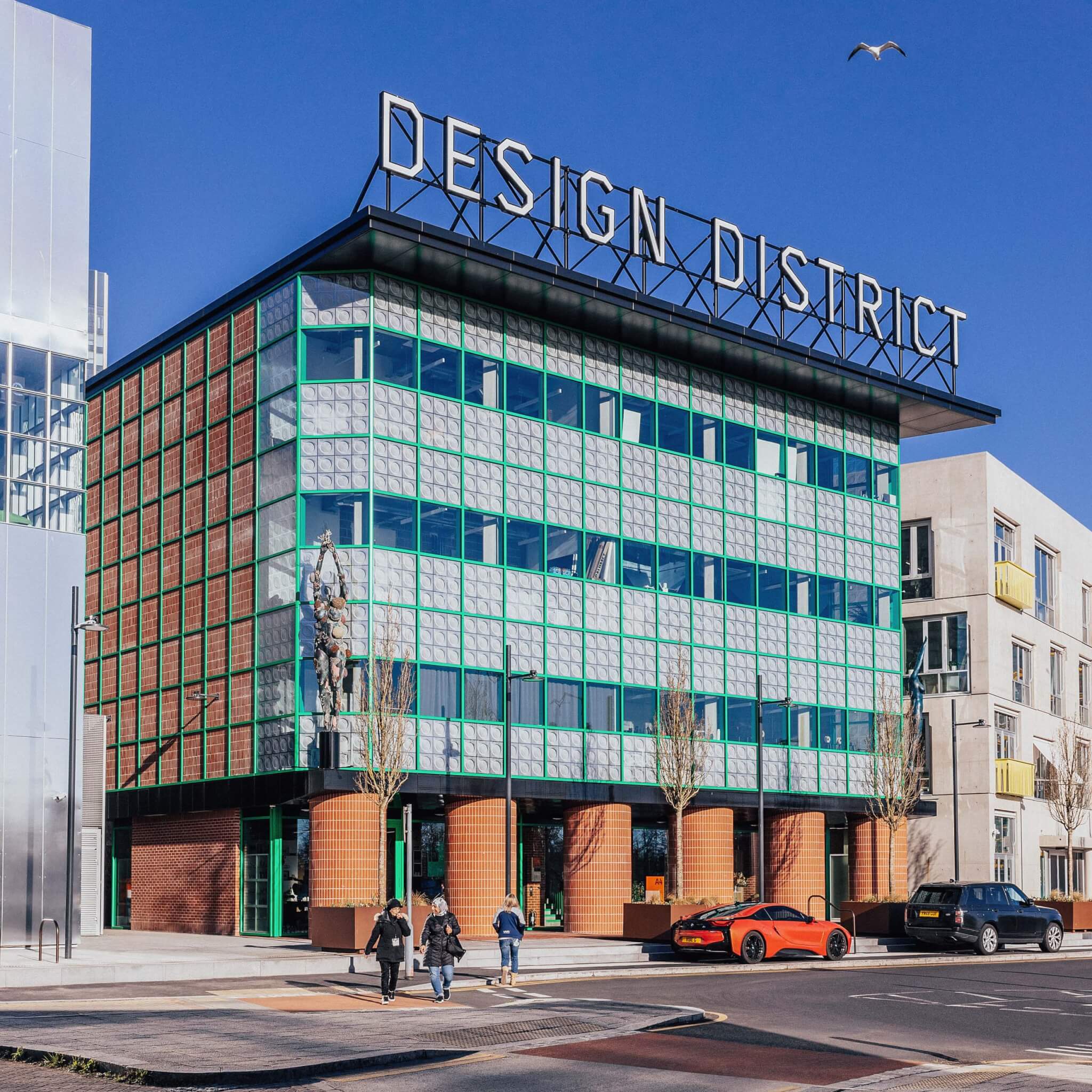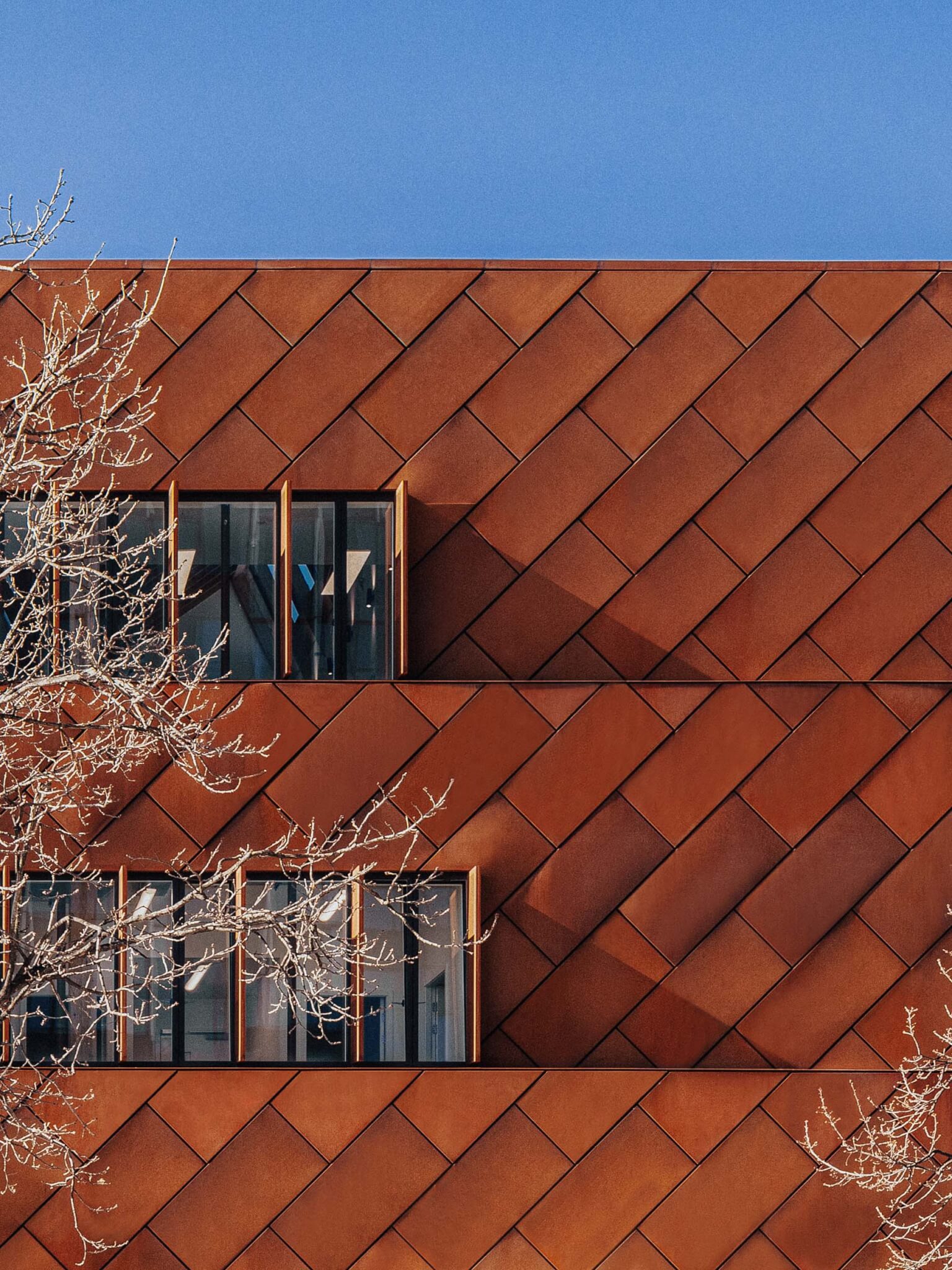“When David Kohn first told me he was designing some workspaces for North Greenwich which would have giant nude figurative statues by Damien Hirst on the facade I thought he was joking,” said Phineas Harper, chief executive of Open City, a British charitable organization dedicated to making architecture and neighborhoods more accessible and equitable.
Open City moved into the Greenwich Design District when it launched in 2021. Back then, some buildings in London’s first purpose-built creative quarter, realized on top of a former natural gas plant, were still under construction, and they’ve steadily been opening since. A master plan from Allies and Morrison protects views of the adjacent Richard Rogers–designed O2 Arena, capping building heights at four stories. Studio HNNA laid out the circulation, creating a network of mini streets and squares with an array of plots to be filled on the condensed site.


The Design District in this sense is a big architectural experiment—and one that attracted big names. The developer, Knight Dragon, invited eight architects to design two buildings each, with the caveat that all offices work entirely independently. Adam Khan Architects, Architecture 00, Mole Architects, SelgasCano, 6a, Barozzi Veiga, HNNA, and David Kohn Architects all stepped up, with the latter making good on its promise of nude figurines.


The latter’s two buildings, A4 and B4, are laced with playful references. Kohn used the glowing green of James Stirling’s Staatsgalerie for window framing and oversized brick pillars to support the base of A4, which is topped by a Hollywood-esque sign that reads DESIGN DISTRICT. Headless female nudes courtesy of Damien Hirst adorn A4’s corners. Six niches in B4 display works from local artists.
Less colorful, but still just as fun, Architecture 00’s C1 boasts a basketball court on its roof and a metal mesh net as the building’s envelope, allowing floor-to-ceiling sliding windows to fully open without the need for a balustrade. From above, the orange basketball court makes for a good photo, in contrast to the proudly gray building, while at ground level, the mesh provides porosity, allowing the building to be easily read. With its corner plot, the bright orange makes C1 a handy portal to the area. D1, by contrast, also by Architecture 00, is much more understated, eschewing any netting but retaining a set of expressive concrete decks.


Unlike any other firm, 6a architects opted for two almost identical buildings, both easily recognizable by their dramatic slanting roofs. “If you do two buildings and one is better than the other, shouldn’t you just do the better one twice?” Tom Emerson, cofounder of 6a, related to AN in 2020. The two buildings, A2 and B2, are in part inspired by the late American artist Richard Artschwager, attempting, as Emerson remarked, to turn his “graphic, Pop Art expression into a sculptural form.” Architecturally, this manifests as a pair of buildings that celebrate the layers of construction, with a diagrid imprinted onto the slanted roof. “It’s not an explicit reference but allowed us to enjoy working with these architectural products and layers which are ordinary in themselves but together can be interesting and playful,” added Emerson.
Mole Architects takes the opposite approach. “Mole’s two buildings [C2 and D2] are different from each other—one compact and angular, the other stacked like a ziggurat,” said director Meredith Bowles. “[They] play one against the other, the larger one heavy and solid, the smaller one with changing colors, like the flame of burning gas.” Internally, however, the two share the same sensibilities: Made entirely from timber, they evoke the qualities of an old warehouse. C2 features stepped sides and diagonal Corten cladding, while D2 serves up a shimmering facade—or more precisely, pyramidal profiled cladding with a two-tone color that changes with the direction of the light. Fins surrounding the windows in dichroic glass refract colored light over the facades. “The colors are inspired by a gas flame,” said Bowles, who added that the buildings are a nod to Victorian gas holders that originally occupied the site.

Along with its layout of the district, HNNA contributed two buildings: D3, which remains unbuilt while authorities finalize plans for a car tunnel beneath the district, and C3, whose tall, thin windows are fissures in an undulating white exterior inhabited by pocket-sized workspaces. Roz Barr Architects designed the interiors for Bureau, a coworking members’ club featuring a sumptuous lounge dubbed the Salon, dressed top to bottom with striking red furnishings.
Spanish outfit SelgasCano made extensive use of ETFE in the studio’s B1 and Canteen, the latter acting as the district’s central nexus. A bulbous, translucent, caterpillar-like food hall spans two levels, its giant doors swinging open, displaying the mechanics celebrated through its bright yellow structure. B1, the most recent building to finish on site, retains the character of Canteen within its box plot. Working areas are connected by platforms and winding stairs that traverse a four-story winter garden. Buildings A1 and D4 by fellow Spaniards Barozzi Veiga are comparatively orthogonal in form, adding delight through a polished aluminum facade. Cementing the district as a creative hub for the long term, A1 is entirely occupied by the Ravensbourne Institute for Creativity and Technology, a kind of university-sponsored experimental design-and-media makerspace.

Finally, London-based Adam Khan Architects’ A3 offers a moment of architectural respite. Its subdued concrete facade uses awnings on the southern and eastern sides to add character and limit solar heat gain. B3, meanwhile, is on hold, also awaiting transportation infrastructure.
“Today, [the] Design District supports an ecosystem of 160 businesses, encompassing individual makers, ambitious start-ups, groundbreaking social enterprises, and industry leaders,” said Design District director Helen Arvanitakis.

“It’s not a template that should be rolled out everywhere,” Harper offered. “But as a playful and fully pedestrianized cluster of characterful pavilions, it is fantastic place to base the Open City team and has much to teach the po-faced bricky baldness which defines so much new London architecture.”
Jason Sayer is a writer and lecturer based in London. Previously at AN and later the London School of Architecture, he works for U.K. publication Architecture Today.
- Architects: 6a architects, Adam Khan Architects, Architecture 00, Barozzi Veiga, David Kohn Architects, Mole Architects, SelgasCano
- Location: London
- Developer: Knight Dragon











